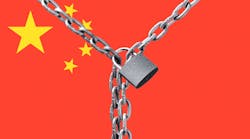A ban of all imports from the region in China most closely identified with forced labor was overwhelmingly approved by Congress over objections initially voiced by President Biden, who signed the legislation into law on Dec. 23.
Days earlier, the legislation had passed the House of Representatives by 428-1 votes and the Senate by 99-1, which made it veto-proof if there had been any continued opposition by Biden, who at the last minute agreed to sign the bill after reportedly seeking to have its language watered down.
In fact, the administration sought to take a stronger stand on Chinese slavery a few days earlier when it announced a diplomatic boycott by the United States of the 2022 Winter Olympic Games in Beijing, blaming China’s “egregious human rights abuses and atrocities in Xinjiang.”
Unfortunately, because administration officials publicly discussed the possibility of a diplomatic boycott before officially announcing it, the Chinese government made them look silly by announcing their own ban on diplomatic representation at the games before the U.S. government got around to doing it.
The Uyghur Forced Labor Prevention Act (UFLPA) prohibits the import into the U.S. of any items mined, produced, or manufactured wholly or in part in the Xinjiang Uyghur Autonomous Region (XUAR) or by persons working with the XUAR government for the purposes of the Chinese “poverty alleviation” or “pairing-assistance” programs.
The new law goes into effect 180 days after its December enactment and establishes a rebuttable presumption that all goods originating from XUAR violate existing U.S. law that prohibits the importation of goods made with forced labor.
“This rebuttable presumption will present significant challenges to businesses with supply chains that might touch the Xinjiang region,” according to attorneys Ludmilla Kasulke and Rory Murphy of the law firm of Squire Patton Boggs. “Many businesses do not have full visibility into their supply chains and will need to act quickly to map their suppliers and respond to identified risks. Importers must present detailed documentation in order to release any shipments that they think were improperly detained, a costly and time-consuming endeavor,” they add.
Creating a Future Strategy
The new law also requires federal officials to solicit public comments and hold a public hearing to assist in developing a future strategy for the enforcement of the import ban. This suggests a real possibility that stricter actions could take place in the future, which means the comments filed by those who are affected could have a real impact on the future shape of enforcement.
There is nothing new about the U.S. government targeting Chinese exports over concerns about that Communist government’s well-established and ongoing persecution of its minority communities. Over the course of several years, evidence has mounted that the Chinese government has unjustly imprisoned more than one million Uyghurs, ethnic Kazakhs, ethnic Kyrgyz and others for indefinite periods in internment camps located in the Xinjiang region.
Since 2019, both the Trump and Biden administrations have banned specific products and materials produced by named companies located in Xinjiang. This was accomplished by the federal government issuing of Withhold Release Orders (WROs) against a number of these products and companies.
The new law takes a different approach from the WROs, which mainly target specific products and named companies. (Exceptions include orders encompassing cotton and tomatoes). In contrast, the UFLPA bans imports of all products from the region unless the importer can meet certain conditions
The most recent of the WROs was last July’s ban on imports of solar panels made with refined polysilicon produced in the region, even if some of the materials come from elsewhere in China. The Biden administration 2021 order also took aim at U.S. companies who may be collaborating with the Chinese government in developing surveillance software and detention facilities.
The federal government first got involved in 2019 during the Trump administration when it issued a WRO banning the import of garments produced in Xinjiang using forced labor. At that time, the government also signed working agreements with several international nongovernmental organizations to assist enforcement personnel and American businesses in their tracking products coming from XUAR through the sharing of information.
One major change in the new law to keep an eye on is that it contemplates the possibility of companies using third-country supply chains as a way to bypass or circumvent the ban on imports from XUAR, note attorneys Fatema K. Merchant and Mario Torrico of the law firm of Sheppard Mullin Richter & Hampton, who expect regulations and guidance documents addressing this point will be issued.
The law’s presumption that all products originating in Xinjiang are produced by slave labor can be rebutted if the U.S. importer can show that it has complied with importer guidance and has completely and substantively responded to all inquiries for information.
“Although this presumption has existed in previous pieces of legislation, what’s different here is that a U.S. importer will have guidance from the government—in terms of documents, due diligence, etc.—on what it needs to have in order to rebut this presumption,” the attorneys say.
What to Watch Out For
As you may have gathered by now, this new law will make life difficult not only for Chinese producers, but also for almost all participants in the U.S. supply chain. “Now is the time to be proactive if your company’s supply chain involves China, particularly in the XUAR,” advise Merchant and Torrico.
They recommend that American businesses consider conducting a supply chain audit or assessment with support from a third party. This audit may consist of onsite visits; worker and management interviews; and an assessment of labor brokers and recruiters; ending with the presentation of final report and results.
“A comprehensive third-party audit and on-site visits with suppliers abroad may not always be feasible, but a lighter-touch assessment involving questionnaires, high-level interviews, and document review could also prove useful in providing information and a high-level understanding of gaps and areas for enhancement,” the attorneys suggest.
When vetting suppliers, make sure that forced labor is part of due diligence. Contracts with suppliers and sub-suppliers should include explicit terms and conditions that prohibit the use of forced labor, a timeframe by which to take corrective action if forced labor is identified, and the consequences that may arise if corrective action is not taken.
To the extent that your existing contracts do not include such language, consider adding it when you renegotiate, or make sure that your current suppliers agree to abide by your policies and code of conduct, Merchant and Torrico add.
Also consider a supply chain mapping exercise to identify suppliers, sub-suppliers and, if possible, assessing your supply chain down to the raw materials level. “This exercise, while certainly a challenge for companies with complex supply chains, will help you evaluate risks and focus your compliance efforts where most needed. In the event you face having to rebut the presumption, the exercise might be invaluable,” they say.
These steps are not always easy to accomplish. Research shows that Xinjiang accounts for almost 20% of global cotton production, with annual production greater than that of the entire United States. Its production of polysilicon used in solar panels makes up nearly half of global production.
The new law aims to help American businesses in a number of ways, Merchant and Torrico note. It requires the government to create detailed lists, including entities in the XUAR use forced labor; the products they produce; exporters of those products; and Chinese facilities and entities that source material from the XUAR.
The government also is directed to create a list of high-priority sectors for enforcement, which will include cotton, tomatoes and polysilicon (already subject to enforcement); and to develop an enforcement plan for each entity which may include issuing WROs and an enforcement plan for each high priority sector.
In addition, Merchant and Torrico say importers sought for the past two years of uncertainty the creation of guidance addressing due diligence, supply chain tracing, and supply chain management for compliance with forced labor due diligence obligations. That guidance, due to be published this summer, also will lay out the type of evidence that demonstrates that a good was not made in the XUAR; and the type of evidence that demonstrates that the good was not made from forced labor.
“The importer guidance will be key for importers rebutting the presumption that a good was made by forced labor,” the attorneys state.




